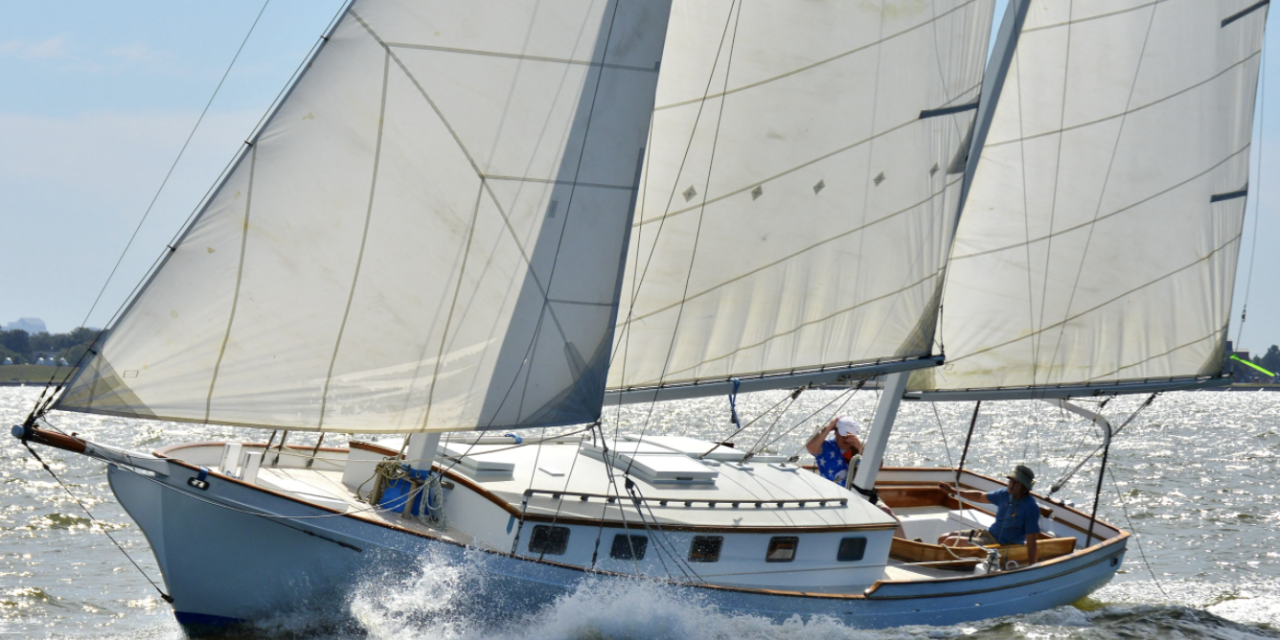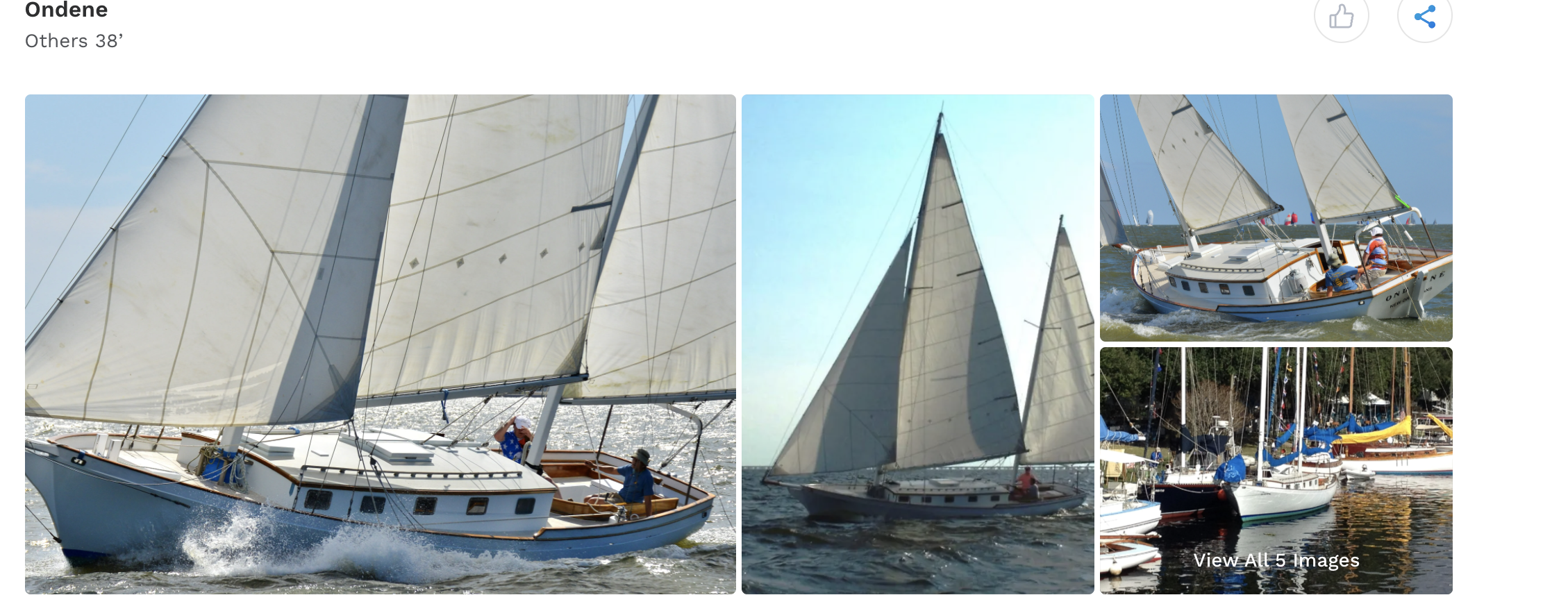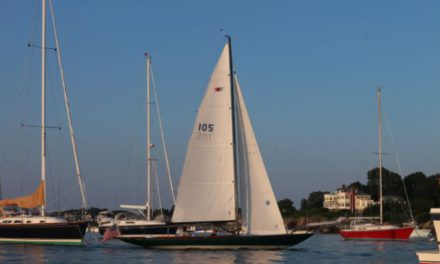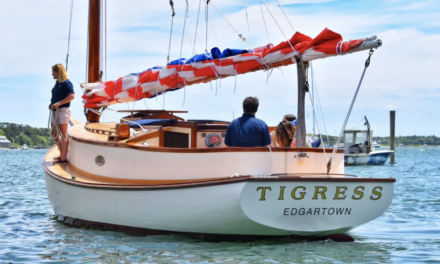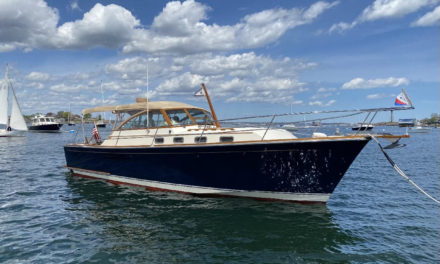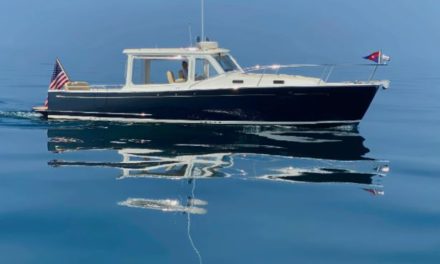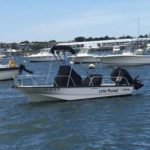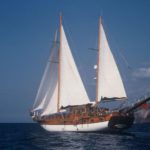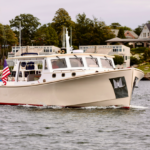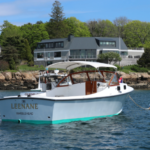“ONDENE was designed by L. Francis Herreshoff in 1947 at the Castle in Marblehead… While ONDENE’s appearance turns a lot of heads, what I like most about her is her simplicity, speed, seaworthiness, and the confidence that she will handle well under tough conditions.”
Ondene, Herreshoff 38′
Interview with the Captain — Skipper Chenault
About the Boat
Why did you choose to buy a Herreshoff?
ONDENE was designed by L. Francis Herreshoff in 1947 at the Castle in Marblehead, as part of Rudder Magazine’s “How to Build” series. His father, Nathaniel Herreshoff, “the Wizard of Bristol” and a great designer in the late 1800s and early 1900s, is a separate story entirely. I grew up knowing about L. Francis Herreshoff’s boats, and had admired the great 72-foot ketch TICONDEROGA since I was about five years old. When the book “Sensible Cruising Designs” came out in the early 70s featuring many of L.
Francis Herreshoff’s designs, I first saw the plans for Nereia.
Nereia is a 36-foot ketch that closely resembles TICONDEROGA and is half her length. Nereia left an impression on me, even though I had begun racing IOR boats about that time. A year or so later I saw the beautiful Nereia ketch ALARIA in Marblehead harbor, and hoped someday to have one. Over the years I reviewed comments about Nereias and other Herreshoff ketches, and thought they would be good boats. ONDENE is a Nereia “stretched” two feet to 38 feet, which makes the head and galley roomier. She has turned out to be everything I had hoped for.
What other kinds of boats did you consider before buying this particular model (and how did they
compare)?
I had spent a lot of time racing and cruising on sloops in the 40 to 60-foot range, designed by Sparkman and Stephens, Frers, Peterson, and some other good designers. They were great boats, but not practical for sailing with a small crew. I was not particularly interested in a modern cruiser type like a Beneteau or Hunter. My father and brother had built a Herreshoff Rozinante ketch from a bare fiberglass hull, so I got to spend some time sailing on it. The Rozinante was a lot of fun, and made me appreciate the ketch rig for the type of sailing I wanted to do as I got older.
How did you come to find/locate her before purchasing (and what’s the boat’s history if you know it)?
In the late 1990s, I began searching the web to see what I could find out about Nereias. I was convinced one would be a good for what my brother and I wanted to do, but only wooden ones seemed to be available. In the summer of 2009, I saw that a 38-foot wooden Nereia was for sale in south Florida that had been built by a professional boatbuilder and had been epoxy fiberglassed during construction. My brother and I did a road trip to see her, were comfortable doing the needed repairs, then bought her.
While the boat seemed to be in very good condition, we had her trailered to Lake Pontchartrain because we did want to do a long late-fall offshore sail in a boat that we didn’t know. We learned that boatbuilder Bob Sutcliffe had built ONDENE in 1975 for his own use. Bob had access to good resources, hand-picked all the lumber, and didn’t cut any corners. With an epoxy fiberglassed
strip-planked hull, we don’t have to worry about caulking seams or many of the problems associated with wooden boats. Bob had also “stretched” the boat two feet, which gave her a little more room below. Bob owned and sailed ONDENE for about 30 years. We bought her from the second owner, who had her for about four years.
Who first introduced you to sailing?
My Dad had sailed since he was very young, and introduced me to sailing. He and my mother were building a wooden Friendship sloop when I was born. They took me sailing in a wicker basket when I was an infant. They had to sell the Friendship sloop when he was transferred inland, but when we got back near the water he built a wooden Penguin dinghy, and later, a Thistle from a fiberglass hull. When I was in college, he and my brother built a Herreshoff Rozinante ketch from a bare fiberglass hull.
What boats have you previously owned?
I’ve had the luxury of sailing some very fine boats that I didn’t own, mostly racing boats. For a few years I owned a Laser, then a 23-foot, Alberg-designed Kittiwake sloop. Both were good boats, but totally different. For several years I was a co-owner of our family’s Herreshoff Rozinante, which we sold after buying ONDENE.
What are the features you like most about your boat?
While ONDENE’s appearance turns a lot of heads, what I like most about her is her simplicity, speed, seaworthiness, and the confidence that she will handle well under tough conditions. I frequently single-hand her, which is very easy with the ketch rig. She lays into the wind very nicely with the mizzen up, and each of the sails is small enough for one person to easily handle. We’ve never reefed the main, despite some heavy weather conditions. Instead, we simply drop the main and sail her “jib and jigger”
with the jib and mizzen. Her sail area remains equally split fore and aft, is reduced 50%, so she remains well balanced.
Surprisingly, we had the best corrected time in a 40-boat fleet in a distance race where we sailed the windward leg jib and jigger in heavy air. At the windward mark we raised the main, eased off a bit to a close reach, and flew while many boats were still reefed and struggling. ONDENE isn’t a speed demon in light air, but as the breeze and the seas pick up, so does her speed while providing a smooth, steady ride.
What features/improvements have you added or do you plan to add?
We’ve had ONDENE almost eleven years, but haven’t really added any improvements. ONDENE is fitted with the fractional working jib shown in Herreshoff’s sail plan, which has been great in moderate to heavy wind. A friend gave us a sail that has become our mizzen staysail. I am intrigued about adding a masthead drifter or cruising spinnaker to improve her light air performance.
Do you belong to a yacht club or other boating organizations (and what’s your homeport)?
ONDENE’s home is in Bayou Castine in Mandeville, Louisiana, on the north shore of Lake Pontchartrain. I am a member of the Corinthian Sailing Association of Lake Pontchartrain, but not currently a member of a traditional yacht club.
What is the biggest challenge you have in servicing your boat?
Wood! Because ONDENE is wooden (including the spars), my brother and I do a lot of the work ourselves. Our Dad taught us a lot about working with wood. I like to think of her as having a wood-core fiberglass hull, but that still leaves a lot for us to maintain on a 46-year-old boat. We have replaced the entire mizzen mast partner, related deck beams and deck, deck around the mainmast, cockpit coaming sections, bulwark sections, rudder cheeks, and bowsprit sections. It’s always something. Fortunately we’ve been able to do these things ourselves; we’re not ready to entrust her to a boatyard that does 95% of its work on fiberglass boats.
Do you have any notable boating/sailing resources you use (whether they be websites, books, or other resources)?
I think WoodenBoat magazine is a great resource, even if you don’t have a wooden boat. Anyone interested in learning more about L. Francis Herreshoff should read the two-volume biography recently written by Roger Taylor, and the book “Sensible Cruising Designs”, which Roger Taylor published. If you are interested in Nathanial Herreshoff, I recommend that you read “Capt. Nat Herreshoff – The Wizard of Bristol”, written by his son, L. Francis.
Do you have any advice for those looking to buy a Herreshoff like yours?
L. Francis Herreshoff’s (and Capt. Nat’s) boats have withstood the test of time. They are proven designs from a different era when seaworthiness and seakindliness were more important than accommodations. Herreshoff boats will look good, be dependable, and behave well even when the conditions get tough. Anyone interested in buying a boat needs to honestly assess how he/she will use the boat and what his/her priorities are. Double berths may be nice in port, but are totally impractical while beating to
windward in a sea.
L. Francis would probably say if you wanted comfortable accommodations, don’t buy a boat, rent an apartment. A lot of L. Francis Herreshoff’s designs have been built, especially in the U.S., Australia, and New Zealand. Someone interested in a used boat like ONDENE should thoroughly investigate the boat’s history, hire a dependable surveyor to examine the boat, and honestly determine whether they will be able to maintain the boat. I would recommend fiberglass or aluminum boats over wooden boats, even though they are harder to find.
What’s the story behind the boat’s name?
As I understand it, builder Bob Sutcliff chose the name ONDENE as a combination of two of his children’s names, Jon and Deanna. But there is a little more to the story of why I wanted to keep that name. L. Francis wrote that “Nereia was one of the many daughters of Nereus, the sea god.” In mythology, an Ondine or Undine is a water nymph, something like a Neriad. Another piece of this is that at the time ONDENE was built, the big ketch ONDINE, owned by Sumner Long and based nearby in south Florida, was one of the hot ocean racers of the day. Her predecessor, another successful ocean racer also called ONDINE was given to the Naval Academy. I’m a Naval Academy graduate, and concluded that it with all of these connections, it would be bad luck to change her name.
Check it Out
Click the gallery below for more photos and information about Ondene!

